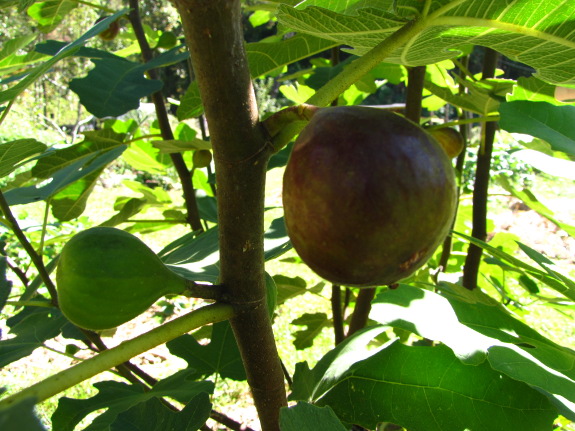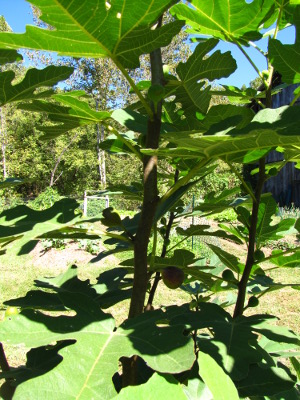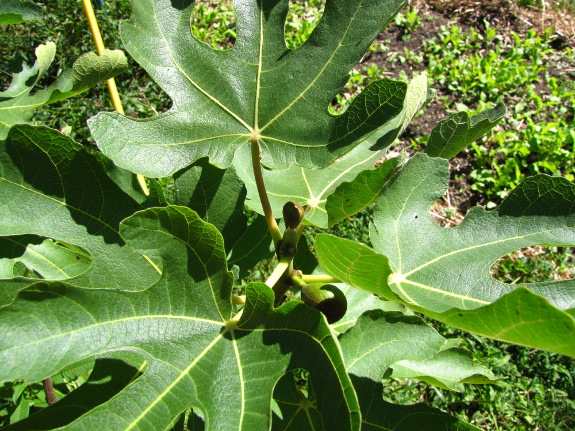
Cold hardy figs

When we started thinking
about expanding our
fig planting, I
decided to do some research on figs that can grow here in zone 6 (and
even for those of you in zone 5). I'll write a later post about
frost protection; for now, I want to talk about selecting varieties
that can handle the cold best.
Before you start
thinking about frost hardy figs, though, you need to understand that
young figs of any variety are more sensitive to cold winters than
larger figs are. Depending on who you talk to, figs less than two
to five years old are likely to die back to the ground regardless of
your efforts. In addition, wet feet over the winter make a fig
more likely to  perish.
So, don't lose heart if you've planted a supposedly hardy variety and
it spends its first few years dying back and producing little fruit ---
the tree might grow out of it, especially if you provide better soil
drainage.
perish.
So, don't lose heart if you've planted a supposedly hardy variety and
it spends its first few years dying back and producing little fruit ---
the tree might grow out of it, especially if you provide better soil
drainage.
Okay, so which figs are
likely to achieve hardiness? As I searched the internet, I
discovered that fig aficionados talk about varieties you're unlikely to
find in most nurseries. In fact, you might have to join one of
the fig forums and beg for cuttings if you want to try these heirlooms.
The good news is that
fig lovers have also put a lot of effort into testing the cold
hardiness of their varieties, in one case setting out over a hundred
types of figs and letting the plants deal with a cold winter to see
which few survived. Sal (Gene strain), Marseilles vs Black, Blue
Celeste, and Hardy
Chicago were the
winners in that experiment, which had a winter low of 0 F.
Another fig grower reports that Hardy Hartford is his most cold hardy
variety, surviving -4 Fahrenheit with no winter protection.
During a winter that only got down to 10 F, the following varieties
were added to the cold hardy list:
- Florea
- Gino
- English Brown Turkey (aka Eastern Brown Turkey)
- Sweet Georg
- Adriana
- Tiny Celeste
- UCD Celeste
- 143-36
- Paradiso White (Gene Hosey strain)
- Archipel
- Lindhurst Wht
- Jurupa
Yet other sources add
the following figs to the cold hardy list:
- Brooklyn White
- Violetta
- Hanc Mathies English Brown Turkey
- LaRadek's English Brown Turkey
- Sal's EL
- Dark Portuguese
- Paradiso
- Alma
- LSU Gold

Another factor to
consider in addition to sheer cold hardiness is the fruiting nature of
the variety in question. Figs produce two crops: the breba crop
early in the season on last year's wood, and the main crop later on new
growth. We chose Chicago Hardy (aka Hardy Chicago) because it
will produce a large main crop even if it freezes to the ground during
the winter, but I'm starting to realize that a main crop that ripens in
September is never going to produce as much fruit as a fig that can
give us an especially early breba crop as well. Some sources say
that Celeste (aka Malta, Celestial, Conant, Sugar Fig, and Tennessee
Mountain Fig) can produce a heavy crop as early as June, as long as
prune sparingly and use frost protection. Stay tuned for
tomorrow's post about protecting figs over cold winters.
| This post is part of our Fig lunchtime series.
Read all of the entries: |
Want more in-depth information? Browse through our books.
Or explore more posts by date or by subject.
About us: Anna Hess and Mark Hamilton spent over a decade living self-sufficiently in the mountains of Virginia before moving north to start over from scratch in the foothills of Ohio. They've experimented with permaculture, no-till gardening, trailersteading, home-based microbusinesses and much more, writing about their adventures in both blogs and books.
Want to be notified when new comments are posted on this page? Click on the RSS button after you add a comment to subscribe to the comment feed, or simply check the box beside "email replies to me" while writing your comment.

Elizabeth --- It looks like Charlottesville is one zone warmer than us --- zone 7 --- so you might be able to get away with no frost protection. It might be worth protecting it for its first year or two, though.
Rena --- Interesting! We'll have to give that a try if we pull out the grill. I was just thinking about it today --- that it had cooled down enough it would actually be fun.
Hey, Just wondering if you would ever spare a few cuttings of your Florea. I'd totally send you money for cuttings. Email me if interested. Thank!
Interested in buying or getting any fig cuttings that would grow in central Missouri. Zones 5-6. I also need tons of both fresh and dried fig leaves to make tea's for a few of my clients as well. So if you have spare cold hardy fig cuttings to sell or trade or extra fig leaves(for lowering and controlling high blood pressure and other ailments) I need a ton of leaves for my free herbal clinic that I do each year for poverty stricken areas. I will not be selling or making any money off these, I give the consultation and herbs free of charge to those who lack funds to see a doctor. Please none sprayed with any chemicals. I can also trade for some herbs, a free consultation or other vegetable seeds, if you can spare them please contact me! yayahelligan@yahoo.com Dr. Carla Northcott PO BOX 23 Sunrise Beach Mo 65079 Thank you very much!